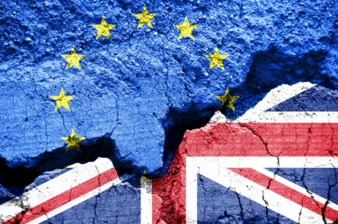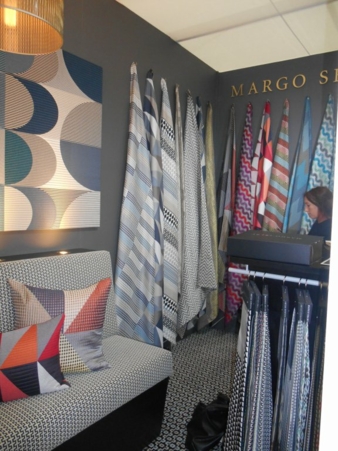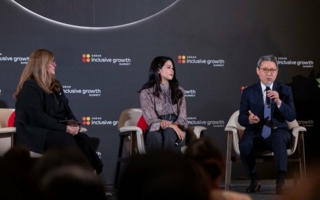17/11/2016 – London Design Festival — auf Deutsch lesen
In the shadow of Brexit
Every September, London becomes the mecca of the design world. The festival in the city on the Thames draws in people from far and wide.
The "London Design Festival" takes place in seven London districts, in elegant showrooms, disused factory buildings and exciting outdoor locations, as a complement to the three main fairs - Decorex in Syon Park, 100 % Design at Earls Court and Focus at the Chelsea Harbour Design Centre.At the start of the festival, Nigel Farage hit the headlines once again. After disappearing like a shot after the Brexit vote, he loudly proclaimed in the lurid British tabloids: “We must leave the EU as quickly as possible.” British companies are by no means in agreement. "We were incredibly disappointed with the outcome of the vote,” explains Amanda Back, Head of Communication for Designers Guild. "We’re an international company, we act and think like Europeans.
And we’ll do everything we can to ensure nothing changes for our customers." The German representative of a big British carpet supplier was just as dismayed. "We were so shocked at the result of the vote. None of us saw it coming. We will have to keep an eye on developments and then discuss how to respond."The fact that Brexit is preying on everyone’s mind was demonstrated only too well at a panel discussion that generated a lot of attention at the London trade fair Decorex. Interior decorators and designers aired their views on "the post-Brexit future of British design”.Other respondents at the trade fairs expressed their hope that the final exit would take a long time. Hopefully "at least two or three years. Until then, it’ll be business as usual," says the London office of a big German textile publisher. Stark Carpets chimed in with this view. "We’ll wait for two or three years to see what happens. We’ll just have to wait and wonder." Nobody really knows what is in the pipeline. And that is precisely the problem.
Business remains sceptical
GTAI - Germany Trade & Invest, the economic development agency of the Federal Republic of Germany, Berlin, reports that British businesses are sceptical about the future. "In a survey published on 18/19 July 2016 by the British Manufacturers’ Organisation EEF, the companies interviewed expressed their concern over the future," stated the GTAI. Furthermore: "Around 38 percent of the companies interviewed said they intended to curb investments over the next twelve months following worsening economic conditions in the wake of the referendum. This compares with 9 percent intending to increase investments and around 43 percent who will make no changes at all.”
Although the weakness of sterling is likely to boost British exports, companies worry about domestic demand. Almost a third of companies asked by the EEF (29 percent) fear they will experience a fall in domestic orders over the next six months.Whilst the majority of companies participating in the survey (53 percent) see opportunities in the weakness of the pound, three quarters (75 percent) view the volatile exchange rate as a risk. Since the referendum, the pound sterling has lost considerable ground to the Euro and the US dollar. It is not perhaps until you spend some time in the UK as a continental European that you begin to realise just how seriously the Brexit vote has split the country. There’s no breakfast TV without a debate over Brexit. No daily newspaper without Brexit comments.
The UK’s new foreign minister Boris Johnson has finally spoken in the British press. BoJo, as the Brits have nicknamed him, asserts that no country in Europe drinks more Italian wine than the UK and that “the Italians won’t want to pass up that opportunity.” Former Tory minister Nick Herbert’s reaction was scathing as he warned that the three cabinet ministers Boris Johnson, Liam Fox and David Davis, who have been charged with the Brexit process, would bumble around the world like “three blind mice”, spewing out inconsistencies and contradictory views as to how Brexit should be executed. As we went to press, Britain’s Prime Minister Theresa May announced she would be pushing for a "hard" Brexit, adding fuel to the fire, among others, in Scotland.
Tradition and modernism
Beyond the discussions surrounding Brexit, the products shown at the fairs reflected the sheer abundance of creative and innovative fabric developments, which included, of course, the traditional British country style with its more subtle floral designs. Sanderson, for example, was inspired by English cottage gardens with delicate grasses and blooms. Tricia Guild recreates motifs from old drawings and copper etchings such as those by world travellers, including courageous women such as Maria Sibylla Merian.
Digital prints are being used with greater frequency as they produce "much more brilliant colours," says Amanda Back. "Textures are becoming more important," says Tricia Guild. Clarke & Clarke mixes floral patterns with stripes and geometrics. Mulberry Home is moving between ethnic Ikat-inspired stripes and Oriental looking patterns. The creative minds at Colefax & Fowler and Jane Churchill are looking to the future as they call for a new, modern British look that embodies luxurious elegance. The Isle Mill, on the other hand, is offering traditional, masculine woollen fabrics in shepherd’s plaid, herringbone and dog’s tooth designs etc. for sofas and armchairs, whereas Margo Selby presents sophisticated jacquards in modern, geometric interpretations.
Floral patterns are also appearing on rugs and carpets. Alternative Flooring’s interpretation of its Liberty fabrics licence has great artistic appeal. The Rug Company is pinning its hopes on the pull of prolific designers such as Paul Smith, Vivienne Westwood and Elie Saab, who are also lending their unique signatures to rugs. Finally, texture is playing an increasingly central role in carpets with relief-like weaves and sophisticated devorés.All in all, it’s well worth keeping the Brits on our radar. Not only from a political point of view.





